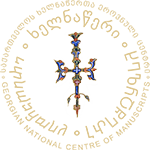

The oriental fund mainly holds Persian, Turkish and Arabic manuscripts. The stored manuscripts are signed under K, L, and ArAC collections. Collection K – personal collection of Tbilisi-based Jashid Ardashir Apshar Majd Os-Saltane 19th-20th centuries. Collection L , also known as local collection – manuscripts from Georgian, Azerbaijan, Dagestan and Turkish regions. The L collection also holds manuscripts that were purchased from private people. Collection L is a growing collection. ArAC collection (Middle Asian Collection) contains manuscripts gathered by David Chkhenkeli and George Tsereteli while travelling to Samarkand, Bukhara and several other middle Asian cultural centres. These manuscripts, in 1935, were passed to State museum of Georgia.
Arabic collection of manuscripts – the collection stores thousands of manuscripts, dating from 14th to 19th centuries (ArK, ArL, ArAC). The content of manuscript is mainly educational: Grammar, logics, rhetoric, mystics, geometry, medicine etc.; The most notable works are Ibn-Sinas’ “Law of Medicine” (ArKg), which paleographically dates back to 14th century, Ismail Al-Javhars’ two volumes (ArK1 and ArK2) of explanatory dictionary. The collection has many works of famous Dagestanian writers and scholars (ArL576, ArL 460), grammar, dogmatic and lexicographical manuscripts (ArAC349, ArAC588, ArAc589) etc..
Fund of Turkish Manuscripts (TurL, TurK, TurAC) – this collection stores several hundreds of Turkish – Ottoman, Azerbaijan, Turkmen and Uzbek manuscripts. Including, works of Alisher Navoi (Uzbek poet 1441-1501), “Munshaati”, re-written in 1519, “Farhad and Shirin” re-written in 1526, re-written inventory of Fuzuli, the Azerbaijan poet (1494-1556) and Hadikad Ulau-Ada (1583,1586 and 1596), inventory of Ottoman official made in 1595 in South Georgia and other.
Though, the most notable of works must be acknowledged and it is a Mongolian manuscript written in Uyghur Arabic alphabet and is about genealogical history of a high-ranking Buddhist monk.
Collection of Persian Manuscripts (PL, PK and PAC) – in the L collection of Persian manuscripts several hundreds of manuscripts are preserved and date back to 15th-19th centuries.
The collection mainly holds secular literature (prose as well as poetic pieces), historical, theological, astronomical and medical manuscripts. Rather significant manuscripts are re-written inventory (1428) of poetic collection by Azerbaijan humanist Nizam Ganjeli (1141-1203/09) (PAC458), Astronomical treaty re-written in 15th century (PL612), “History of the Herati city” re-written in 1698 (PK35/69) and other.
Fund of Armenian manuscripts (Arm) – the collection holds around 300 manuscripts, of which big part is written on a parchment using old Armenian (Grabar) and new Armenian (Ashkharbar) alphabets. The manuscripts date from 15th to 19th centuries. The collection mainly stores ecclesiastical works such as hagiography, apocryphal, ascetical, homiletic and dogmatic-polemic compositions. But, apart from these, there are also historical, medical, astronomical, grammatical and other original as well as translated works. The most notable works include fragment of “Glorification explanation” (Arm135) re-written by Grigol Noseli in 9th-10th centuries, liturgical collection re-written in 1382 (Arm173), Gospel collection re-written in 14th century (Arm216) etc.;
Other manuscripts that are as relevant as others are examples of Armenian original literature: “Words” (Arm4) by the poet of 10th century, Grigol Narekeli, 18th century Inventory (Arm7) of historian Stefano Taronecci (Asogiki), short history of destruction of Tbilisi by Agha-Mohammad Khan (1794-1797) (Arm98, Arm22).
Fund of Jewish manuscripts – the fund generally holds full or fragments of manuscripts written on parchment. The manuscripts date from 10th to 19th centuries.
The fund mainly stores biblical books and other material, such as Tors (Hebr. 5, Hebr. 11), interpretation of book of Esther (Hebr. 24), prayers (Hebr. 12). The most notable work of the fund is the Lailashi Bible (to be used as a main inventory for the new edition of holy letter Hebrew texts). The collection also holds parchment books of 16th century: Psalms with commentary (Hebr. 4) and two bibles (Hebr. 18,19).
Fund of Syrian manuscripts (Syr) – the collection holds manuscripts of a rather later period. The material dates from 18th to 19th centuries. One of the manuscripts (Syr 1) displays Arabic liturgical texts using Syrian font, the other two manuscripts (Sur 2 and Syr 3) contain prayers, which are decorated with the miniatures of saints and heralds.
Fund of Ethiopian manuscripts (Eth) – The fund only stores one manuscript, which dates back to 10th century. The manuscript contains psalm texts and is written on a parchment.

